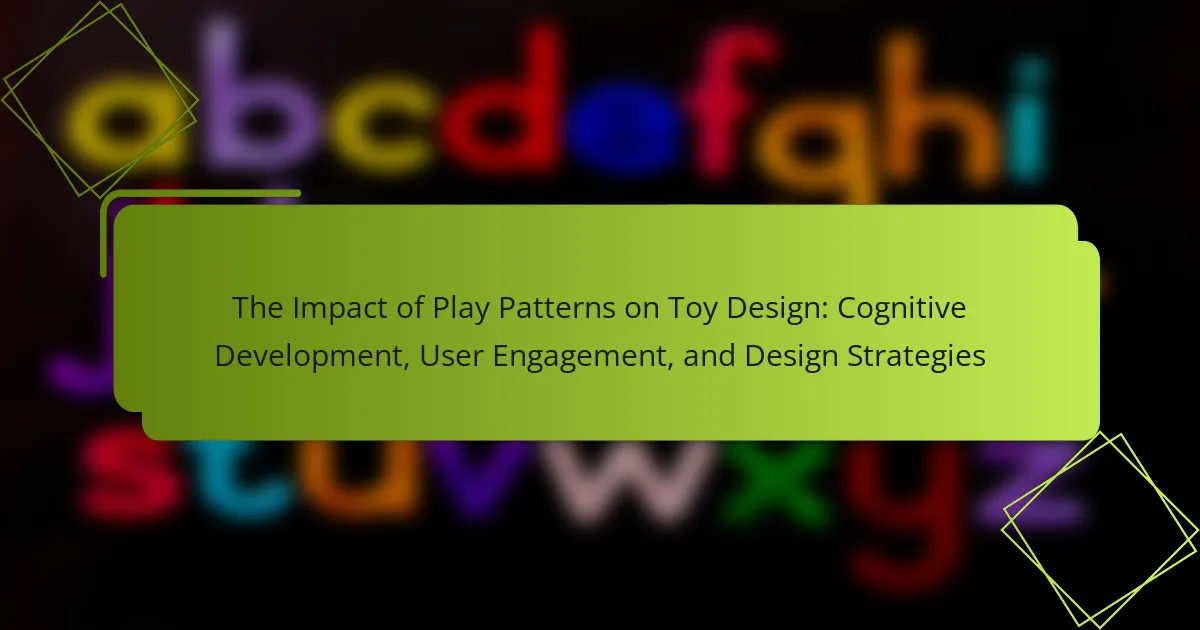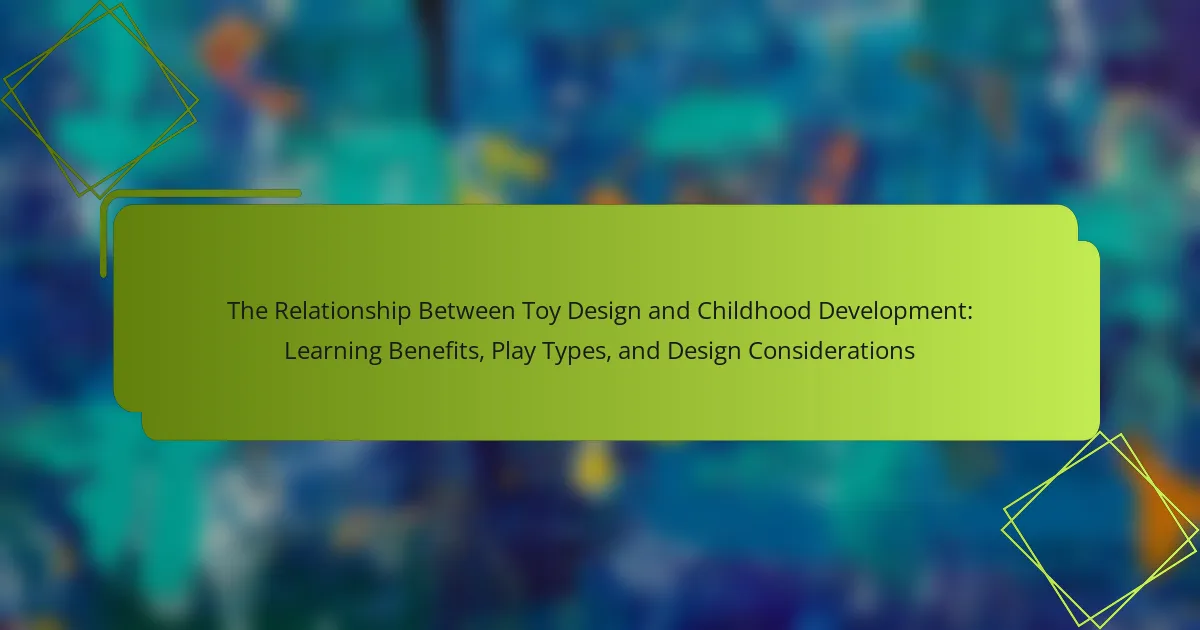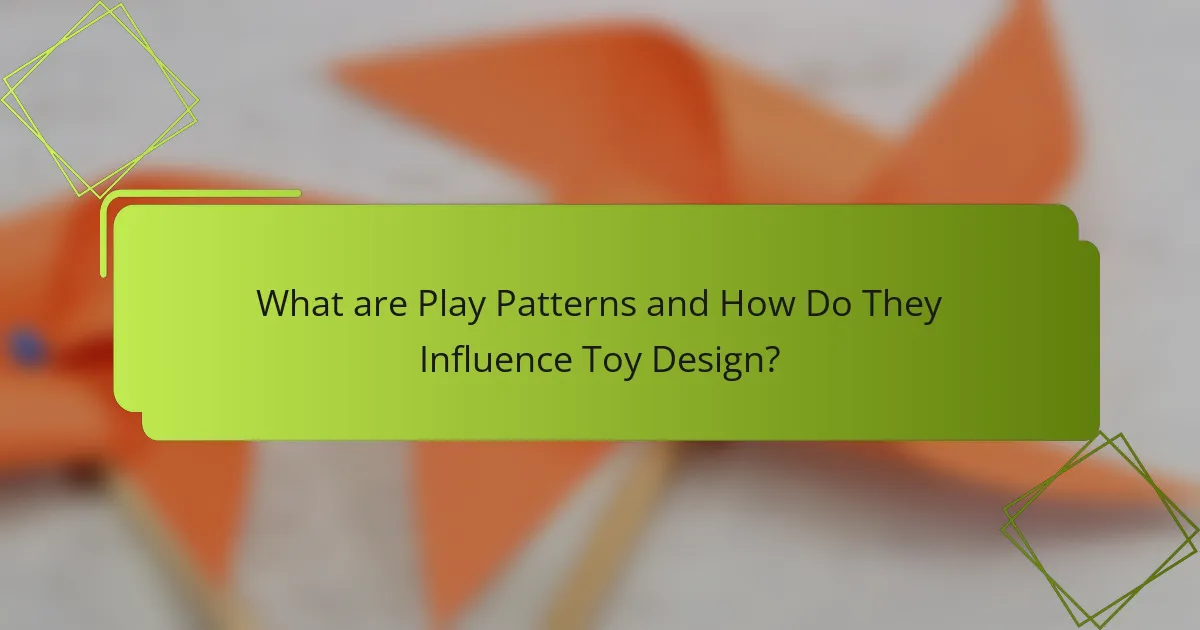
What are Play Patterns and How Do They Influence Toy Design?
Play patterns are the ways in which children engage with toys during play. They encompass various activities, such as imaginative play, constructive play, and social play. Understanding these patterns is crucial for toy designers. It allows them to create products that align with children’s developmental needs and preferences.
For example, imaginative play often involves role-playing and storytelling. Toys that encourage this type of play, like dolls or action figures, are designed with features that stimulate creativity. Constructive play focuses on building and creating, leading to toys like blocks or construction sets that promote problem-solving skills.
Research indicates that toys aligned with play patterns enhance cognitive development. A study by the American Academy of Pediatrics found that play is essential for healthy brain development in children. Furthermore, toys that cater to social play can improve communication skills and teamwork.
In summary, play patterns significantly influence toy design by guiding the creation of products that support various types of play. This alignment fosters engagement and developmental growth in children.
Why are Play Patterns Important in Cognitive Development?
Play patterns are crucial for cognitive development as they facilitate learning through exploration and interaction. Engaging in various play patterns enhances problem-solving skills and creativity. Children learn to navigate their environment and understand cause-and-effect relationships during play. This interaction fosters cognitive flexibility, allowing children to adapt their thinking to new situations. Research indicates that play promotes the development of critical thinking and social skills. For instance, a study by Pellegrini and Gustafson (2005) found that children who engage in diverse play patterns demonstrate improved cognitive abilities. These patterns also encourage language development through social interactions during play. Overall, play patterns serve as a foundation for cognitive growth, enabling children to build essential skills for future learning.
What Types of Play Patterns Exist and How Do They Impact Learning?
Types of play patterns include solitary play, parallel play, associative play, and cooperative play. Solitary play involves children playing alone, which fosters independent thinking and self-regulation. Parallel play occurs when children play side by side without direct interaction, promoting social awareness and observational learning. Associative play involves more interaction, where children share materials and ideas, enhancing communication skills and collaboration. Cooperative play is characterized by organized activities with shared goals, which develops teamwork and problem-solving abilities. Research indicates that these play patterns significantly influence cognitive development. For instance, cooperative play has been shown to improve executive function skills, as demonstrated in a study by Vygotsky, which emphasizes social interaction in learning. Thus, understanding these play patterns can inform toy design, enhancing user engagement and supporting developmental milestones.
How Do Different Age Groups Exhibit Varying Play Patterns?
Different age groups exhibit varying play patterns based on their developmental stages. Infants engage in sensory play, exploring textures and sounds. Toddlers often participate in parallel play, where they play alongside peers without direct interaction. Preschoolers shift to associative play, sharing toys and ideas while still focusing on their own activities. School-age children engage in cooperative play, working together towards common goals. Adolescents may prefer more structured activities, often incorporating technology and social interaction. Research shows that these shifts in play patterns are linked to cognitive and social development, influencing toy design to cater to each age group’s unique needs and preferences.
How Do Play Patterns Affect User Engagement with Toys?
Play patterns significantly influence user engagement with toys. Different play patterns, such as solitary play, parallel play, and cooperative play, shape how users interact with toys. Solitary play often leads to focused engagement, as users explore toys independently. In contrast, parallel play encourages social interaction, which can enhance enjoyment and creativity. Cooperative play fosters teamwork and communication, increasing the time spent with toys. Research shows that toys designed for specific play patterns can enhance user satisfaction. For example, toys that promote cooperative play can lead to longer play sessions and deeper connections among users. Understanding these dynamics is essential for toy designers aiming to create engaging products.
What Features in Toy Design Enhance User Engagement Based on Play Patterns?
Interactive elements in toy design enhance user engagement based on play patterns. Features such as sensory stimulation, versatility, and social interaction promote deeper play experiences. Sensory stimulation can include textures, sounds, and lights, which attract attention and encourage exploration. Versatile toys that can be used in multiple ways foster creativity and adaptation in play. Social interaction features, like cooperative play options, enhance engagement by encouraging collaboration among users. Research shows that toys designed for cooperative play improve social skills and communication. These features align with different play patterns, catering to solitary, parallel, and cooperative play preferences.
How Can Understanding Play Patterns Improve Toy Longevity and Appeal?
Understanding play patterns can significantly enhance toy longevity and appeal. By analyzing how children interact with toys, designers can create products that cater to various play styles. Toys that align with play patterns often engage children longer. For instance, toys that encourage imaginative play can foster creativity and sustained interest. Research shows that toys designed for cooperative play increase social interaction, making them more appealing. Additionally, toys that adapt to different developmental stages can remain relevant as children grow. A study by the American Academy of Pediatrics highlights that engaging play leads to better cognitive outcomes. This evidence supports the idea that understanding play patterns directly influences toy effectiveness and desirability.
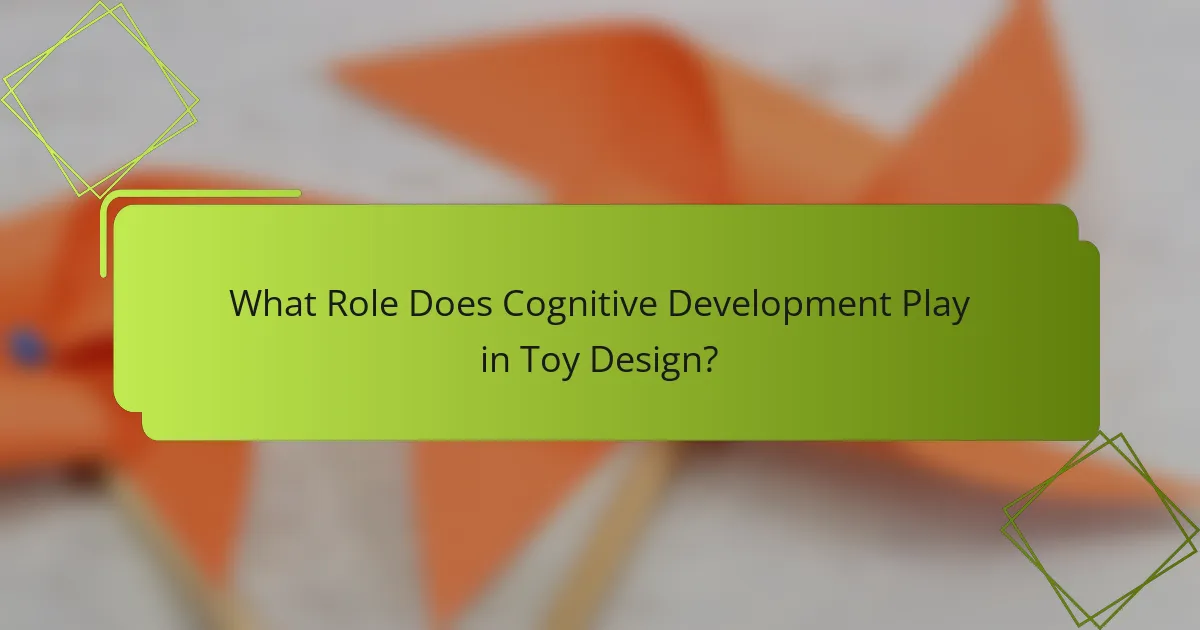
What Role Does Cognitive Development Play in Toy Design?
Cognitive development plays a crucial role in toy design. It influences how toys are created to enhance learning and skill acquisition. Toys designed with cognitive development in mind promote problem-solving, critical thinking, and creativity. They often include features that stimulate imagination and encourage exploration. Research shows that toys can support various stages of cognitive growth. For example, building blocks enhance spatial awareness and motor skills. Educational toys can improve memory and attention span. The alignment of toy features with cognitive milestones ensures they are age-appropriate and beneficial. Overall, cognitive development informs the design process to create toys that foster learning and growth.
How Do Toys Facilitate Cognitive Skills in Children?
Toys facilitate cognitive skills in children by promoting problem-solving, critical thinking, and creativity. Engaging with toys encourages children to explore their environment and develop reasoning abilities. For instance, puzzles enhance spatial awareness and logical reasoning. Building blocks foster creativity and understanding of basic physics principles. Research shows that interactive toys can significantly improve memory and attention span. According to a study published in the Journal of Child Development, children who engage with educational toys demonstrate higher cognitive skills compared to those who do not. Thus, toys serve as essential tools for cognitive development in early childhood.
What Cognitive Development Milestones Should Toy Designers Consider?
Toy designers should consider several cognitive development milestones. These milestones include problem-solving skills, memory development, and language acquisition.
For infants, toys that encourage sensory exploration are crucial. They help develop cognitive skills through tactile and visual stimulation. As children grow, toys that promote imaginative play enhance creativity and critical thinking.
At preschool age, toys that require sharing and cooperation foster social cognition. They teach children about teamwork and communication.
For older children, complex puzzles and strategy games support advanced reasoning skills. These activities challenge their cognitive abilities and enhance decision-making.
Research indicates that play is vital for cognitive growth. According to the American Academy of Pediatrics, play helps develop brain architecture and cognitive skills.
Overall, integrating these milestones into toy design can significantly enhance children’s cognitive development.
How Can Toys Be Designed to Support Different Learning Styles?
Toys can be designed to support different learning styles by incorporating diverse sensory experiences and interactive elements. Visual learners benefit from toys with bright colors and shapes. Auditory learners engage with toys that produce sounds or music. Kinesthetic learners thrive with toys that require physical manipulation. Toys can include varying complexity levels to cater to different cognitive abilities. For instance, puzzles can range from simple shapes to complex patterns. Additionally, toys that encourage collaborative play can enhance social learning. Research shows that multi-modal learning enhances retention and understanding. A study by Dunn and Dunn (1993) highlights the importance of catering to individual learning preferences in educational settings.
What Strategies Can Be Employed in Toy Design to Foster Engagement?
Strategies employed in toy design to foster engagement include incorporating interactive features, using appealing aesthetics, and promoting social play. Interactive features, such as sound and movement, capture children’s attention and encourage exploration. Appealing aesthetics, including bright colors and unique shapes, attract users and enhance play experiences. Promoting social play through cooperative games or multiplayer options encourages children to engage with peers. Research indicates that toys designed for social interaction lead to longer playtime and increased cognitive development. Additionally, incorporating feedback mechanisms, like lights or sounds in response to actions, further enhances engagement.
How Can Interactive Elements in Toys Enhance Play Experiences?
Interactive elements in toys enhance play experiences by promoting engagement and fostering cognitive development. These elements can include sounds, lights, and responsive features. They encourage children to explore and interact more deeply with the toy. Research shows that toys with interactive features can improve problem-solving skills and creativity. For instance, a study by the American Academy of Pediatrics highlights that interactive play can lead to better memory and learning outcomes. Additionally, toys that respond to a child’s actions can create a sense of agency, making play more rewarding. This active participation keeps children interested and motivated. Overall, interactive elements transform passive play into dynamic learning experiences.
What Design Techniques Promote Open-Ended Play and Creativity?
Design techniques that promote open-ended play and creativity include modular design, flexible materials, and interactive elements. Modular design allows children to assemble and reassemble components in various configurations. This encourages exploration and innovation. Flexible materials enable users to manipulate objects in diverse ways. This adaptability fosters imaginative play. Interactive elements engage users actively, prompting them to experiment and create. Research shows that toys designed with these techniques enhance cognitive development and user engagement. For instance, a study by Fisher et al. (2011) found that open-ended toys significantly boost creativity in children.
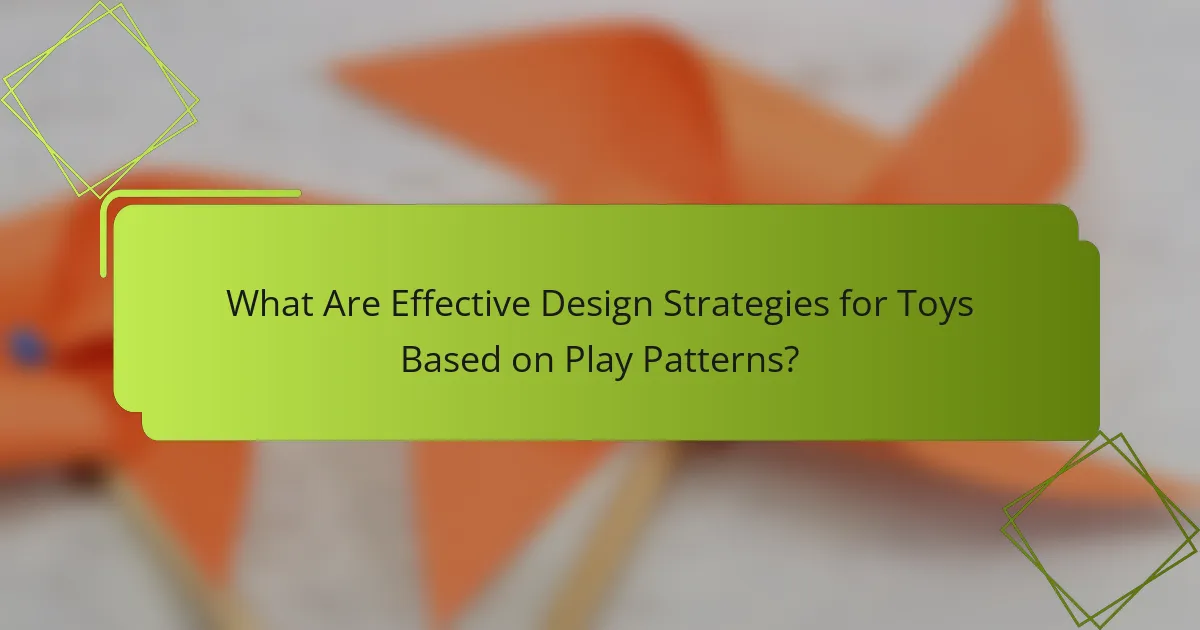
What Are Effective Design Strategies for Toys Based on Play Patterns?
Effective design strategies for toys based on play patterns include understanding different types of play, such as solitary, parallel, and cooperative play. Designers should create toys that encourage interaction and collaboration among children. Incorporating adjustable difficulty levels can cater to various skill sets and ages. Toys should be versatile to facilitate imaginative play and adaptability to changing interests. Safety and durability are essential attributes in toy design to withstand active play. Research shows that toys promoting problem-solving enhance cognitive development, making them valuable for learning. Engaging sensory elements, like textures and sounds, can attract children’s attention and enhance their experience.
How Can Designers Incorporate Play Patterns into the Design Process?
Designers can incorporate play patterns into the design process by analyzing user interactions and behaviors. Identifying common play patterns helps in understanding how users engage with toys. Designers can then create prototypes that align with these patterns. Testing these prototypes with target audiences provides valuable insights. Feedback from users can guide further design iterations. Research indicates that play encourages cognitive development and engagement. For example, studies show that toys promoting imaginative play enhance creativity. By integrating play patterns, designers can create more effective and engaging products.
What Research Methods Can Be Used to Understand Play Patterns?
Qualitative and quantitative research methods can be used to understand play patterns. Qualitative methods include observations, interviews, and focus groups. These approaches provide in-depth insights into children’s behaviors and preferences during play. Quantitative methods involve surveys and experiments that yield measurable data on play patterns. For instance, surveys can quantify the types of toys children prefer and how they engage with them. Observational studies can track play behavior in natural settings, revealing patterns over time. Both types of research contribute valuable information for toy design, enhancing cognitive development and user engagement.
How Do Prototyping and Testing Influence Design Strategies?
Prototyping and testing significantly influence design strategies by providing iterative feedback. This feedback helps designers refine concepts based on user interactions. Prototyping allows for visualizing ideas and testing functionality before final production. Testing reveals user preferences and pain points, guiding modifications. Research indicates that 75% of design changes occur during the prototyping phase, enhancing overall product effectiveness. Additionally, testing can lead to improved user engagement, as designs are tailored to meet user needs. Ultimately, these processes ensure that the final product aligns with cognitive development goals in toy design.
What Best Practices Should Designers Follow When Creating Educational Toys?
Designers should prioritize safety, educational value, and engagement when creating educational toys. Safety involves using non-toxic materials and avoiding small parts that pose choking hazards. Educational value should align with developmental milestones, promoting cognitive and motor skills. Engagement can be achieved through interactive features that stimulate curiosity and creativity.
Incorporating feedback from educators and child development experts enhances the toy’s effectiveness. Testing prototypes with children helps identify areas for improvement. Research shows that toys designed with these principles can significantly enhance learning outcomes. For instance, a study by Hirsh-Pasek et al. (2015) emphasizes that play-based learning fosters critical thinking and problem-solving skills in children.
How Can Feedback from Parents and Educators Shape Toy Design?
Feedback from parents and educators can significantly shape toy design. Parents provide insights on safety, usability, and educational value. Educators contribute knowledge about developmental milestones and learning outcomes. This collaboration ensures toys meet children’s needs effectively. Research shows that toys designed with parental input enhance engagement and cognitive development. For example, a study by the American Academy of Pediatrics emphasizes the importance of interactive play in early childhood. By incorporating feedback, designers can create toys that foster creativity and critical thinking. Ultimately, this leads to products that are not only fun but also beneficial for child development.
What Common Mistakes Should Be Avoided in Toy Design for Cognitive Development?
Common mistakes in toy design for cognitive development include using overly complicated designs. Complex toys can confuse children and hinder learning. Another mistake is neglecting age-appropriate features. Toys must match the developmental stage of children for effective engagement. Additionally, failing to incorporate open-ended play can limit creativity. Toys should encourage exploration and imaginative thinking. Lastly, ignoring safety standards can pose risks. Safe materials and designs are crucial for children’s well-being. These mistakes can significantly impact cognitive growth and learning outcomes in children.
The main entity of this article is play patterns and their influence on toy design. The article explores how different play patterns, such as imaginative, constructive, and social play, guide toy designers in creating products that align with children’s cognitive development needs. It discusses the importance of understanding various age-specific play patterns and their impact on user engagement, cognitive skills, and learning outcomes. Additionally, the article highlights effective design strategies, research methods for understanding play patterns, and best practices for creating educational toys that foster creativity and critical thinking in children.
